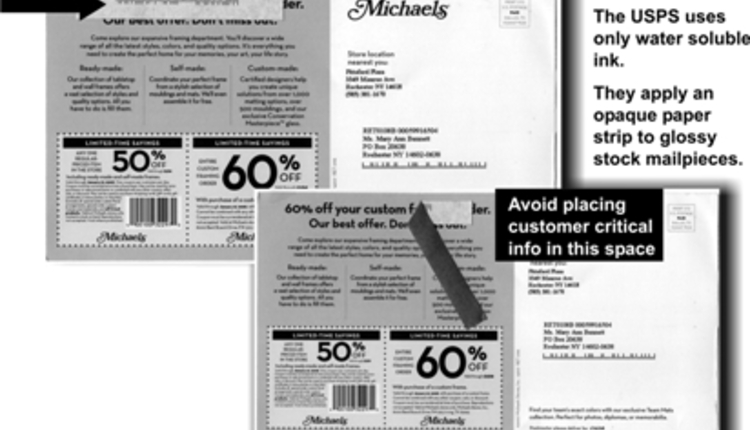
- Mailers will need to spend money to participate in the Full Service Intelligent Mail program, and it provides them with no ROI benefit. The current incentives are very low ($3/m for First Class and $1/m for Standard Class) and may go away in the future. (http://www.gao.gov/cgi-bin/getrpt?GAO-09-599) Until at least May 2011 (possibly November of 2011), automation postage discounts will be granted for mailings with POSTNET barcodes and the basic Intelligent Mail barcode.
- Passing performance verification testing by MERLIN at the time of mail acceptance does not preclude the possibility of automation discounts being taken later if errors are found with the information embedded in the Intelligent Mail barcode. "Samples from the mailing are processed on MERLIN and evaluated for mail preparation including presort and barcode readability quality." ("The Postage Discount No Mailer Wants": http://deadtreeedition.blogspot.com/2009/11/postage-discount-no-mailer-wants.html) It is not known how many MERLIN installations have been updated to handle the additional software needed to process Intelligent Mail barcoded mail. MERLIN will need to not only check the physical characteristics of the barcode (print contrast ratio, tilt and skew, etc.), but it also will need to be able to look up the address information and verify the mailpiece has the most current address for the addressee. (http://ribbs.usps.gov/intelligentmail_latestnews/documents/tech_guides/merlin/MERLINRPT.pdf)
- The Intelligent Mail barcode is not human readable and it will be necessary to purchase scanner equipment to read and interpret the data embedded in the barcode.
- Currently, there are no PAVE testing requirements by the USPS to certify that software vendors are correctly producing and correctly embedding data in the Intelligent Mail barcode. Within the Intelligent Mail barcode, the Routing Code is meant to contain ZIP Code data if it is being populated. Postal rules deem acceptable, a wide latitude of data for the Intelligent Mail barcode's Routing Code including a 5-digit ZIP Code or no ZIP Code at all. By comparison, the POSTNET barcode cannot be generated without a valid delivery point ZIP Code. With "anything goes" data permitted in the Routing Code, even addresses failing the ZIP+4 DPV encoding process produce an Intelligent Mail barcode that appears to be perfectly acceptable. (https://ribbs.usps.gov/intelligentmail_mailpieces/documents/tech_guides/getstrtd/USPSIMB_Getting_Started.pdf) This wide latitude of acceptable data adds to the problem of the mailer having no idea by visual inspection what data is embedded in the Intelligent Mail barcode.
- Additional software or enhancements of current software will need to be purchased that produces the additional barcoding requirements for Intelligent Mail pieces, Intelligent Mail trays and Intelligent Mail containers. Each piece, tray and container must have unique Serial numbers that are not reused for 45 days from time of mailing acceptance.
- Postage statements must be submitted electronically through PostalOne! The GAO has concerns over the safety and reliability of the USPS to protect your security and money. The preferred method to submit electronic postage statements requires the purchase and licensing of software Mail.dat. This software has yearly licensing fees. An additional concern surrounding the electronic submission of Postage Statements, is the fact that several mailers are experiencing hours of processing time to submit electronic files. The USPS has released no information regarding its computer capability upgrades to handle the volume of processing needed to process electronic postage statements. (http://www.presort.com/?p=230; http://ribbs.usps.gov/intelligentmail_latestnews/documents/tech_guides/PostalOneCriticalIssueExtCustomers.pdf) The USPS' PostalOne! system crash experienced by mailers from Friday, February 5, 2010 to Tuesday, February 9, 2010 demonstrates that concern about the reliability of this system is well founded. Also the lack of a real contingency plan to compensate for this system's outages adds to the concern for mailers. From the February 12, 2010 PostCom Bulletin 06-10 "When the Postal Service's systems crash, it has a significant and costly impact on the mailers' ability to prepare and enter mail." (http://www.postcom.org)
- All Intelligent Mail barcode mailings must be scheduled through the FAST system for drop-off appointment times to their postal facility. Delays have been reported with the access to the FAST system to schedule appointments. (http://www.presort.com/?p=230)
- If acceptance issues require rework of a mailing, with the service type id embedded within the barcode representing the class of mail, pieces could require additional presorting and repackaging as well as replacement of the barcode.
- Postal acceptance personnel inducting Intelligent Mail barcode mailings need training and familiarity with new Intelligent Mail barcode mailing procedures. (http://www.presort.com/?p=230)
- Programs such as ACS and Confirm with the Intelligent Mail barcode have USPS costs (they are not free as the USPS would like you to think) associated with their use. Vendor supplied software or services must be purchased to interpret that data returned from these programs.
1 New Barcode Readability Standards, http://ribbs.usps.gov/index.cfm?page=intellmaillatestnews
This information is accurate as of February 15, 2010. The issue of implementation of the Intelligent Mail Barcode is very fluid and we suggest that you regularly visit the sites referenced in this document for the most "current"âââ information.
Revised February 17, 2010. Document link in #2 updated to give proper accreditation.
Mary Ann Bennett is President/CEO of The Bennett Group, Inc., a mailing training and consulting firm, and is founder of the Mailing Training Institute located in Rochester, New York. She can be reached at 585-424-2702. Email: maryann@the-bennett-group.com. Web: http://www.mailingtraining.com/





